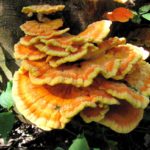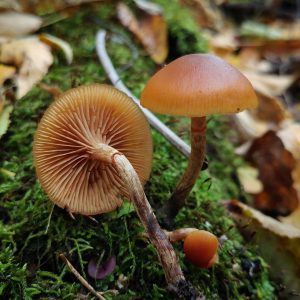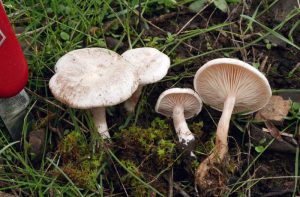American mycophiles get used to being told that this or that well-known species doesn’t actually grow in North America after all—that we really have one or more other, related, species, and that taxonomy and identification are far more complicated than we had supposed. The reason for this recurrent pattern is that American mushrooms were long mistaken for look-alike species scientifically described in Europe. That means that for an American mycophile to visit the UK often involves a strange kind of home-coming—because here grow the supposedly familiar species for real. There are also some mushrooms that really do occur on both continents, either naturally or as a result of introduction, as well as some species that are obviously distinctively European[i].
Articles like this are not intended as foraging guides. Learning to identify mushrooms well enough to safely eat them is a time-consuming and exacting process—it’s usually not difficult to identify mushrooms, once you learn how, but don’t expect to find a totally unfamiliar mushroom growing, find out what it is, and have it for dinner that night. A good analogy might be driving a car—it’s not that driving is all that hard (except under certain conditions), it’s that it takes time to learn. And no one who hasn’t put in the time and effort to learn can be expected to do it safely.
The purpose of this article is to give you some reasons to put in the effort. It is not meant to replace a field guide, spore prints, or an identification app. It is strongly advised to seek guidance from an expert in person if you plan to go mushroom hunting. Additionally, it is crucial to bring a high-quality knife and a basket or bag.
Here are some of the mushrooms you can look forward to finding.
Our Recommended Field Guides for the United Kingdom
COVER | TITLE | Header | ||
|---|---|---|---|---|
OUR #1 RATED | ||||
Edible Wild Mushrooms
Agaricus Mushrooms












Agaricus mushrooms are, arguably, the true mushrooms; the word “mushroom” originally applied to the species whose white buttons you get at the grocery store (you’ll notice they don’t have any common name besides “mushroom”) and therefore to their wild equivalents. Gradually, the usage of the word seems to have widened. In any case, there are poisonous members of the group, and some have dangerous look-alikes, but many of these true mushrooms make excellent table fare.
The Prince (Agaricus augustus)[ii], as the common name suggests, is not only large but also delicious. The distinctive scent of bitter almonds (a scent otherwise associated with cyanide) is worrisome, but the UK version of this species has not made anybody sick. Field Mushroom (Agaricus campestris) is the closest wild equivalent of the domestic species. Horse Mushroom (Agaricus arvensis)[iii] has a poisonous look-alike, but its aniseed-like scent and the fact that the stem does not turn yellow quickly when cut help keep things clear. The cap does bruise yellowish. This species can accumulate heavy metals from the soil, so it should not be eaten in excess. Scaly Wood Mushroom (Agaricus langei)[iv] and Blushing Wood Mushroom (Agaricus sylvaticus)[v] both turn a distinctive red when cut. Salty mushroom (Agaricus bernardii)[vi] is not salty-tasting but can grow in salty, seaside habitats. It also turns red when cut but smells of aniseed.
Note that this genus once included all umbrella-shaped fungi with gills, but most have been reassigned. The word “agaric” is still part of the common names of many gilled species.
Boletes












Boletes have the same umbrella-like shape as agarics, but with a smooth surface dotted with pores in place of gills. This group, too, were once considered a single genus, but not only have many been reassigned, but the taxonomy of the group is currently in a state of flux, with some boletes getting multiple new scientific names in just the past few years. Many, though not all, are edible.
Penny Bun (Boletus edulis) is considered one of the best edible mushrooms around. Other common names for the same species include king bolete, cep, and porcini. Brown Birch Bolete (Leccinum scabrum)[vii] is considered almost as good but can be difficult to properly identify without a microscope. Bay bolete (Imleria badia)[viii] is also similar to penny bun and very good, though the coloration of its stem is notably different. Larch bolete (Suillus grevillei)[ix], Slippery Jack (Suillus luteus)[x], and Weeping Bolete (Suillus granulatus)[xi] are all slimy-topped mushrooms brown or yellow in color, and edible but not very tasty. Eating them gives some people gastrointestinal upset as well. There are other edible boletes in the UK, too, but few, if any, are well-regarded.
Puffballs












Puffballs are not a true taxonomic group. That is, although at least five of the UK’s puffballs are members of the same genus, “puffball” really only refers to a ball-shaped mushroom with spores on the inside, and some mushrooms that fit that description are not related at all to others. May puffballs are edible, but not all are—those who claim otherwise are more or less defining puffballs as edible and referring to inedible ball-shaped puffs as false puffballs. That hardly seems fair.
Common Puffall (Lycoperdon perlatum), Meadow Puffball (Lycoperdon pratense), Mosaic Puffall (Lycoperdon utriforme), Pestle Puffall (Lycoperdon excipuliforme), and Stump Puffball (Lycoperdon pyriforme) are all small to medium-sized. Most have some rough texture to their skins and sit on a short, thick stem, meaning they somewhat resemble upside-down pears in shape. They are edible provided the interior flesh has not yet begun to color or darken with age, though proper identification is critical. Not only do they resemble earthballs, which are toxic, but they can also resemble young Amanitas in their egg stage, some of which are deadly. Be sure to cut a puffball in half to make certain the interior is homogeneous and white before cooking.
Giant puffball (Calvatia gigantea) is, as the name implies, large enough that it’s hard to mix up with anything. Its skin is smooth, and it has no stem. It is edible, provided the interior is still white, but can spoil quickly once picked. They must be refrigerated, and finding space for one in the fridge can be a challenge.
Blewits






Blewits sound as if they ought to be blue, and indeed Wood Blewit (Lepista nuda)[xii] and Sordid Blewit (Lepista sordida)[xiii] are blue or purple—it’s an unusual color for a mushroom, but not unique, and not all blue or purple species are good to eat, so careful identification is still important. Field Blewit (Lepista saeva)[xiv] is brown. All three are edible (if cooked) for most people—some react badly to these species. They are not considered choice, but do come up at a season when few other edible mushrooms are available.
Edible Amanitas






The Amanita genus is famous for including some of the most deadly-poisonous mushrooms in the world, but there are also edible Amanitas—most experts advise leaving these alone, too, for fear of mix-ups, but it’s worth knowing that these mushrooms exist.
Blusher (Amanita rubescens)[xv] is safe to eat when properly cooked, although identification can be a problem as both size and color are extremely variable. It does turn red if bruised or cut, a distinctive trait. Tawny Grisette (Amanita fulva)[xvi] is a pretty, brown or brownish-capped mushroom without a stem ring. Cooking destroys its toxins, but not those of some of its look-alikes. Gray-Spotted Amanita (Amanita excelsa)[xvii] could be mistaken for the blusher, though it does not blush, or for the toxic panther-cap, although its spots are gray, not white. Reportedly, it’s edible, though not very good.
Oyster Mushrooms






Oyster mushrooms are so named because of their appearance—some are a soft, gray color, like a raw oyster—not their taste, but they are tasty. Most have a delicate flavor and a soft, delicate texture. Many are easy to cultivate but seldom appear for sale as they have a short shelf-life and don’t transport well. Some may have medicinal value, according to preliminary research.
Gray Oyster (Pleurotus ostreatus) is the best-known species, the one people mean when they refer to “oyster mushroom” without specifying. Branched Oyster (Pleurotus cornucopiae)[xviii] does, indeed, usually branch, with two or more caps per stem. The stems are thick relative to the caps and attached to the center of the cap, not the sides as with many other oysters. Pale Oyster (Pleurotus pulmonarius)[xix] is similar to the gray oyster except it fruits in warmer weather and is, yes, paler.
A Flock of Mushrooms






These mushrooms are neither closely related nor especially similar to each other, but they are all popular edibles whose common names can be easily mixed up. Hen-of-the-woods (Grifola frondosa) looks a bit like a dense pile of gray chicken feathers. It’s also known by the Japanese name, maitake, and tastes surprisingly good fried with cheese, like a cheese-steak. Chicken-of-the-woods (Laetiporus sulphureus) is yellow or orange in color and does, indeed, taste like chicken. Fried Chicken Mushroom (Lyophyllum decastes)[xx], in contrast to the other two, has gills rather than pores and grows from disturbed ground rather than from wood. It, too, reportedly tastes like chicken.
Milkcaps




Milkcaps are a group of mushrooms notable for releasing fluid when their gills are cut. The color of the fluid and how the color changes with exposure to air is an important detail for identification. Not all milkcaps are edible, but at least two of the UK’s milkcaps are. Saffron Milkcap (Lactarius deliciosus)[xxi] has orange “milk” that turns red, and they are orange in general. Whether they are delicious or merely OK is a matter of opinion. It is almost certainly more than one species, but the details are not fully worked out yet. False saffron Milkcap (Lactarius deterrimus)[xxii] also has orange milk that turns red, but its skin is merely orangish with greenish patches. It bruises green when damaged. It’s not considered as tasty.
Our Recommended Field Guides for the United Kingdom
COVER | TITLE | Header | ||
|---|---|---|---|---|
OUR #1 RATED | ||||
Poisonous Wild Mushrooms
The following is not intended to be an exhaustive list. Not only have we not attempted to list every known poisonous mushroom species in the UK, but there are species whose status is unknown. That doesn’t mean that every other mushroom out there will kill you. In fact, most mushrooms are not poisonous, and most poisonous ones are only mildly so, and some can be eaten safely by some people. The point is simply to be careful about identification—while most mushrooms won’t hurt you, the consequences of eating one of the few exceptions can be dire.
Poisonous Amanitas








The Amanita genus includes some of the most dangerously poisonous mushrooms in the world. Deathcap (Amanita phalloides) is a large, handsome mushroom with a white stem and gills and greenish or brownish cap. Destroying Angel (Amanita virosa)[xxiii] and Fool’s Mushroom (Amanita verna)[xxiv] are similar in shape but all-white or whitish. All three contain enough amotoxin to kill adult humans; some poisoning victims can be saved by appropriate medical treatment, though diagnosis is difficult because the onset of symptoms can take up to 12 hours. Symptoms naturally go away after a while, which can also lead doctors to believe the patient is safe, while actually the toxin is quietly destroying the liver and kidneys. Although Amanitas have a distinct look, especially at maturity, they are frequently mixed up with various edible gilled mushrooms, and their young “egg” stage can be mistaken for puffballs.
Fly Agaric (Amanita muscaria) Is the famous mushroom with a red cap and white spots (the spots are actually remnants of the universal veil and can wash off). It does not contain amotoxins, but does have other toxins that make eating a fresh specimen very unpleasant and sometimes quite dangerous. If processed properly, its more toxic elements can be reduced, and it is sometimes used as a psychoactive for recreational or spiritual purposes, though even then its side-effects can be severe. Would-be users do well to remember the consequences of getting the recipe wrong.
There are also other Amanitas that, while not dangerously poisonous, do have enough toxin to be unpleasant in one way or another. Even the edible members of the genus are toxic when raw.
Funeral Bell (Galerina marginata)


This species, also called the Deadly Galerina, also contains a lethal dose of amotoxins, but with the added “benefit” of being small, brown, and non-descript, just like lots of edible or psychoactive mushrooms, sometimes even sharing the same habitat. It’s not that it’s impossible to tell the difference but that anyone harvesting mushrooms because they “look right” risks a deadly mistake.
Fool’s Funnel (Clitocye rivulosa)


Fool’s funnel[xxv] is a pretty little white mushroom. Eating one causes excessive salivation, sweating, gastrointestinal problems, breathing problems, and blurred vision. Death is rare but possible.
Brown Rollrim (Paxillus involutus)


Brown rollrim or poison paxillus can confuse mycophiles dangerously. The issue is that this species has two very different toxins. The one that causes digestive upset is destroyed by cooking. The other is not destroyed by cooking and has no initial symptoms but it is cumulative in its effects. So people can eat this mushroom regularly for years with no apparent problem while the second toxin, un-noticed, accumulates in the body, and then suddenly causes the red blood cells to break down. People have died that way.
Common Earthball (Scleroderma citrinum)


Earthballs are poisonous puffballs. There is more than one species, but as the name implies, this one is most common. They are seldom deadly, but are extremely unpleasant if eaten. They differ from edible puffballs in several respects, most obviously in having interior flesh that turns dark very young.
Our Recommended Field Guides for the United Kingdom
COVER | TITLE | Header | ||
|---|---|---|---|---|
OUR #1 RATED | ||||
Psychoactive Mushrooms
Although this list is not intended to be exhaustive either, the UK is not a center of diversity for magic mushrooms. It does have some species[xxvi]. We could put fly agaric on this list, too, as it is sometimes used for its psychoactive properties, but its active ingredient is not psilocybin, and it also contains some seriously unpleasant toxins.
Please note that use or possession of psilocybin is illegal in the UK.
Psilocybes




Psilocybe is not the only genus that contains psilocybin mushrooms, but it’s probably the most famous. It includes the species most popular for recreational use. One of these is Liberty Cap (Psilocybe semilanceata)[xxvii]. It grows in pastures and is reputed to be extremely potent. Blueleg Brownie (Psilocybe cyanescens)[xxviii] was originally discovered in the UK, but it’s probably not native here—it’s likely originally from North America, where it is called wavy cap. There may be other Psilocybes in the UK. In general, these mushrooms are small, brown, and non-descript, making identification a challenge, especially since they look very much like funeral bell.
Other Psychoactives
There are other genera in the UK that produce psilocybin, including Gymnopilus and Inocybe. However, these are not generally used, and it’s hard to know whether they have something else in addition to psilocybin—they might not be safe to use.
Our Recommended Field Guides for the United Kingdom
COVER | TITLE | Header | ||
|---|---|---|---|---|
OUR #1 RATED | ||||
References:
[i](n.d.). Mushroom Identification Guide. The Foraging Course Company
[ii](n.d.). Agaricus augustus Fr.—The Prince. First Nature
[iii](n.d.). Agaricus arvensis Schaeff.–Horse Mushroom. First Nature
[iv](n.d.). Scaly Wood Mushroom. WildFoodUK
[v](n.d.). Agaricus sylvaticus Schaeff.—Blushing Wood Mushroom. First Nature
[vi](n.d.). Agaricus bernardii Quél.—Salty Mushroom. First Nature
[vii](n.d.). Leccinum scabrum (Bull.) Gray—Brown Birch Bolete. First Nature
[viii](n.d.). Imleria badia (Fr.) Vizzini—Bay Bolete. First Nature
[ix](n.d.). Suillus grevillei (Klotzsch) Singer—Larch Bolete. First Nature
[x](n.d.). Suillus luteus (L.) Roussel.—Slippery Jack. First Nature
[xi](n.d.). Suillus granulatus (L.) Roussel.—Weeping Bolete. First Nature
[xii](n.d.). Lepista nuda (Bull.)r Cooke—Wood Blewit. First Nature
[xiii](n.d.). Lepista sordida (Sowerby) Pat. First Nature
[xiv](n.d.). Lepista saeva (Fr.) P.D. Orton—Field Blewit. First Nature
[xv](n.d.). Amanita rubescens Pers.—Blusher First Nature
[xvi](n.d.). Amanita fulva (Schaeff.) Fr.—Tawny Grisette First Nature
[xvii](n.d.). Amanita excelsa var. spissa (Fr.) P. Kumm.—Grey Spotted Amanita First Nature
[xviii](n.d.). Pleurotus cornucopiae (Paulet) Rolland—Branched Oyster Mushroom. First Nature
[xix]Jenny (2022). Phoenix Oyster Mushrooms: Identification and Foraging. Mushroom Appreciation
[xx](n.d.) Fried Chicken Mushroom—Lyophyllum decastes. The Foraging Course Company
[xxi](n.d.). Lactarius deliciosus (L.) Gray—Saffron Milkcap. First Nature
[xxii](n.d.). Lactarius deterrimus Gröger—False Saffron Milkcap. First Nature
[xxiii](n.d.). Amanita virosa (Fr.) Bertill.—Destroying Angel First Nature
[xxiv]Yilmaz, I., Kaya, E., Sinirlioglu, Z. A., Baram, R., Surmen, M. G., Colakoglu, S. (2014). Clinical Importance of Toxin Concentration in Amanita verna Mushroom. Toxicon: Official Journal of the International Society on Toxinology. September (87) 68-75.
[xxv](n.d.). Clitocybe rivulosa (Sowerby) P. Kumm.—Fool’s Funnel. First Nature
[xxvi](2022). 5 Types of Psilocybin Mushroom that Grow Wild in the UK. Mushies
[xxvii](n.d.). Psilocybe semilanceata (Fr.) P. Kumm.—Liberty Cap First Nature
[xxviii](n.d.). Psilocybe cyanescens Wakef.—Blueleg Brownie First Nature






